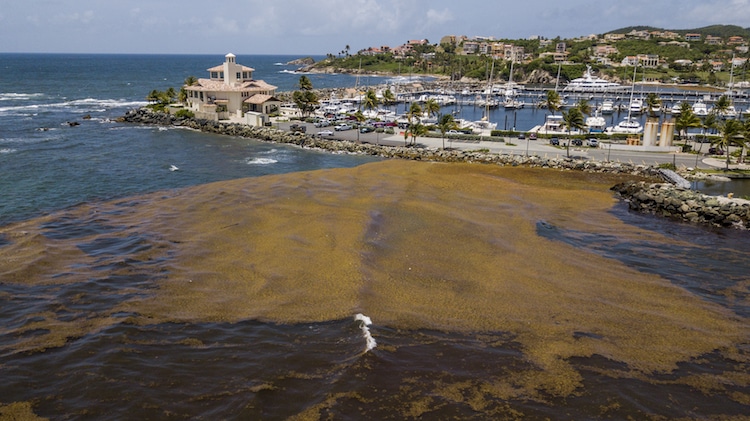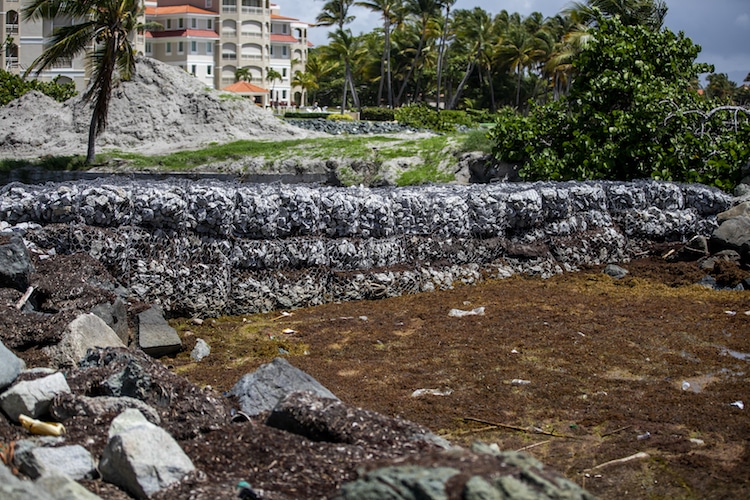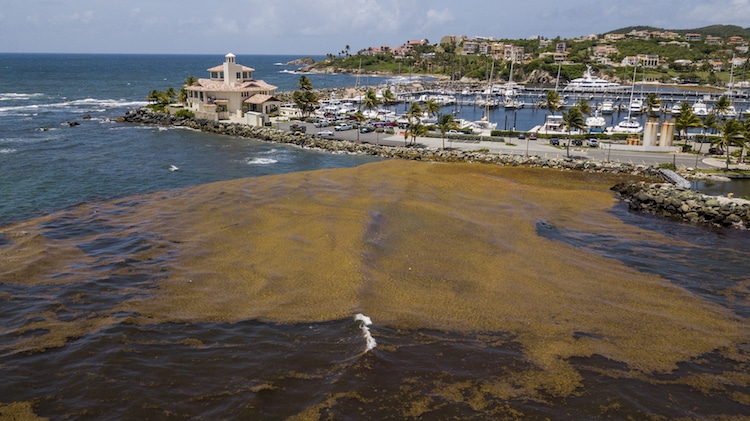On Alfonso XII Street in the Punta Santiago, a coastal neighborhood in Humacao, 62-year-old Bermuda Vázquez points toward the beach that is blanketed with brown seaweed, known as sargassum. Although it was a day off in midsummer to commemorate the emancipation of slavery in the United States, beachgoers were nowhere to be seen.
“The thing is that one is afraid of getting ill in that water with the sargassum that stinks. I’ve lived in this community all my life, and I remember when, on days like today, many people came to the beach. But you have to adapt to this sargassum,” Vázquez told the Center for Investigative Journalism (CPI, in Spanish).
Some 16 kilometers from Punta Santiago, residents of the high end Palmas del Mar complex also deal with the problem of sargassum build-up. The rotten smell caused by its decomposition is much more intense than in other areas. In the outdoor area of Chincho’s Pizza & Beer restaurant, a couple had lunch at noon that Monday.
“We’ve gotten used to that stench here, although it stays on our clothes later,” said a restaurant waitress.
To manage the significant increase of this seaweed, the management of the Palmas del Mar complex decided to build a wall in the water and purchased two sargassum extraction vessels. Meanwhile, in the Punta Santiago community, personnel from the municipality of Humacao or the Department of Natural and Environmental Resources (DNER) have never gone to collect sargassum, residents say.
“In the community we have told the [Department of] Natural Resources about this and other problems, such as the lack of lighting at night, but they do nothing,” Vázquez added.
The problem is repeated in other coastal municipalities. Ten years after the surge in sargassum began to be documented, Puerto Rico does not have a plan at the local level — nor is there a federal plan — to deal with sargassum bursts and establish strategies to maximize the possible benefits or derived uses.
Although 2015 and 2018 were the peak years of algae activity, the projection for 2021 is not encouraging. In May of this year, the accumulation of sargassum in the western central Atlantic and the Caribbean exceeded the mark of all previous years for that month, according to a report from the University of South Florida.

Photo by Xavier García | Center for Investigative Journalism
No federal response to the problem
In La Parguera (in the southwestern coast in Lajas) and Palmas del Mar (in the eastern coast in Humacao), the death of fish coincides with the significant decrease in oxygen levels in the water after the accumulation of sargassum between May and June, according to preliminary results of a study led by scientist William Hernández, of the Research and Development Center of the University of Puerto Rico’s Mayagüez Campus.
“When we compare it with the month of April 2021 [when there was no sargassum build-up] marine life that was attached to the dock structures is no longer there,” said Hernández, whose research focuses on the potential impact of the accumulation of sargassum in coastal areas.
Hernández explained that some areas showed that “dissolved oxygen was below 3 milligrams per liter.” A level below 1 milligram per liter is considered detrimental to marine life. These levels are alarming and can impact organisms like fish, according to the Environmental Protection Agency. In inland areas in the Palmas del Mar marina, there were results “very close” to those levels, he said.
Sargassum in open ocean waters provides benefits such as food and shelter for fish and other species of marine invertebrates. However, during the past decade, the large masses that accumulate on the Caribbean coasts and part of the west coast of Africa represent a danger to the quality of water, air, and the oxygenation processes that make aspects of marine life possible.
Sargassum decomposition results in the emission of hydrogen sulfide and ammonia, which are gases that endanger the health of coastal communities, marine and tourism workers and visitors, as the CPI reported in 2019.
“We don’t know what the impact is regarding long-term exposure [on humans]. There has been no management plan for sargassum. In other Caribbean islands, there’s a policy,” Hernández added.
The DNER barely has a 2015 protocol in which individuals, organizations or communities must contact any of the agency’s regional offices to notify about the area affected by the accumulation of the algae.
Meanwhile, the federal government has not developed policies to face the impact of this marine species in its Caribbean territories. The National Oceanographic and Atmospheric Agency (NOAA) considers sargassum an essential habitat. Therefore, its handling and manipulation are limited by federal regulations that are not updated according to the new climate realities observed since 2011.
But “when does it stop being an essential habitat to become an impact on coastal ecosystems?” Hernández questioned.
The DNER’s Northeast Ecological Corridor Natural Reserve Management Officer, Ricardo Colón, said “federal agencies have a 10- to 15-year lag, while the literature is updated, the NOAA’s own scientists begin to catch up. The agencies have institutional rigidity, and it isn’t compatible with the speed of the environmental changes that they’re supposed to be dealing with.”
The need to update federal regulations related to sargassum management was recognized by engineer Damarys Acevedo, who works for the US Armed Forces Corps of Engineers (USACE). This federal agency, which authorizes infrastructure projects in waters under US jurisdiction, has admitted for the past two years that it does not have an initiative aimed at addressing the sargassum problem in the Caribbean.
“It has been several years since those regulations were established. I think it’s time to review them, especially now that there has been an increase in sargassum bursts in certain areas of the island,” Acevedo acknowledged.
Given its colonial reality, Puerto Rico has been absent from regional summits in which agreements for the management of sargassum are discussed. This absence of strategies in Puerto Rico was again documented in a report published in June by the United Nations (UN) Environment Programme. It only mentions the DNER’s protocol published in 2015 as a reference to manage excessive accumulation on the island.

Photo by Xavier García | Center for Investigative Journalism
DNER disregards the sargassum issue
The nauseating smell invades the coast of Palmas del Mar, because sargassum accumulates in the channels of its marina. In addition, a wall made of stone gabions in one of the channels inhibits the flow of the algae.
The wall was a privately funded and proposed local initiative. Neither the central government nor the USACE were involved in its development, spokespeople for the Palmas del Mar homeowner’s association told the CPI.
“Unfortunately, given the lack of help, be it from the government or the municipality, the [Palmas del Mar Slip Owners] Association and the community have had to come together to do this work and pay for it. More than $175,000 a year is being spent to collect all the sargassum that enters the marina. It’s collected with machines to then find ways to deposit it in either the landfill and in areas that let us do so, they gather it to produce things, but you also have to pay for taking it there because nobody delivers for free,” said Juan Bosch, who is one of the Association administrators through Pelican Management and Realty.
Bosch said although the DNER staff are aware of the efforts in Palmas to manage the algae, there is no communication between the government agency and those who lead the collection strategies within the complex located in Humacao.
When the DNER was asked if it supervises the collection of sargassum in different parts of the island, the agency’s management officer for the northeast natural reserves, Dr. Ricardo Colón did not specify how it goes about it, if at all.
“Private marinas, private businesses like hotels, Palmas del Mar, have the resources to have employees, to find equipment. We know that they make these efforts, and we try to ensure that the protocol is followed, but it isn’t something that should be penalized, but simply improve coordination,” added the scientist.
“Not a single agency has the capacity to deal with this at the Puerto Rico level.” Colón proposed a campaign to inform the public about the DNER protocol. “This is a large-scale problem.”
The CPI requested an interview with DNER Secretary Rafael Machargo on this issue, but he was never available.
The agency does not currently own sargassum extraction machines, but it did have them during the 2013 to 2016 term. DNER Press Spokesman Joel Seijo said that during that period, the machines were transferred to coastal municipalities, although he did not specify which ones. The agency is currently writing proposals to NOAA to buy specialized sargassum extraction machines. Some municipalities like Ceiba have bought their own machines for these purposes.

Photo by Xavier García | Center for Investigative Journalism
Tourism agencies contradict each other on the impact of the problem
Puerto Rico’s destination marketing organization (Discover Puerto Rico), which runs multi-million-dollar campaigns promoting the island’s crystalline beaches, minimized the problem.
“Even the small inns [paradores] that are in the areas most affected [by sargassum], that I know of, haven’t been greatly affected because we have a very active internal tourism. We have multiple options in the same areas, because not all [the beaches] are severely affected. Some are very severe, and then three, four, or 10 kilometers down the road, you have an exquisite beach,” Tomás Ramírez, a member of Discover Puerto Rico’s Board of Directors, told CPI.
“In the paradores, specifically those in the southeast area, 95% of the clients are locals, unlike the west and northwest regions, which have a percentage of foreigners who can account for 35% or 45% of our reservations, and those areas are less affected [by sargassum],” added Ramírez, who owns the Combate Beach Resort in the town of Cabo Rojo.
The Tourism Company agreed in 2019 to transfer $500,000 to the DNER to develop a cleanup plan for Puerto Rico beaches affected by sargassum, according to a document that the CPI had access to. The acquisition of machinery and contracting of specialized services were part of the agreement, but the plan was never executed due to “delays in administrative processes,” as Tourism Co. Executive Director Carlos Mercado admitted to the CPI.
“The Puerto Rico Tourism Co. is working on reactivating the agreement to provide the DNER with additional support in its efforts to manage this situation that puts one of our most important natural resources and tourist attractions, such as the Bioluminescent Bay in Fajardo, our beaches in tourist zones, and other areas of interest, at significant risk,” said the agency head.
The fact that the residents of Palmas del Mar have initiated efforts to deal with the accumulation of sargassum should not be an excuse to exempt the government from its responsibility to address the problem, said Antonio Maldonado, executive director of the Palmas del Mar Homeowners Association.
“Neither the government nor the Department of Health are doing anything. All these studies about gas emissions that we develop here are copied from the French islands [in the Caribbean], because they do an excellent job there and the French government helps, but here, neither the government of Puerto Rico nor the federal government helps,” Maldonado claimed.
A USACE press spokesperson notified the CPI that the federal agency has not received any request from the government of Puerto Rico to establish infrastructure to help control this problem.
Acevedo expressed concern about the possibility that walls or gabions such as the one erected in Palmas del Mar will continue to be developed privately.
“We don’t know if that will have repercussions on the open ocean waters or perhaps in other areas of the island. Maybe that’s a temporary solution, but perhaps that sargassum could be stuck there. Other problems may arise that we’re unaware of,” she said.
Individuals and organizations also come to Palmas del Mar to look for sargassum for research. Bosch said there is no financial transaction involved when the seaweed is extracted.
“Many people have come, I can’t tell you names, to pick it up in trucks. ‘Let me have what you collected; we’re running an experiment.’ We believe it’s not a problem, if they take it,” said Bosch, adding that a portion of the sargassum is used to make compost in the residential and tourist complex.
In Lajas, it was used to cover the municipal landfill and as fertilizer by farmers in the area, former mayor Marcos Irizarry said two years ago.

Photo by Xavier García | Center for Investigative Journalism
Scientific efforts in Puerto Rico and strategies elsewhere in the Caribbean
The recently announced project by Professor Roy Armstrong, from the UPR-Mayagüez Campus, joins multiple university, independent and governmental investigations by scientists in Puerto Rico on this phenomenon. His project, approved by the National Aeronautics and Space Administration, will monitor the path of sargassum through satellite images to better understand its impact on marine ecosystems off the coast of Puerto Rico.
The island is absent from international decisions on this issue. Between 2015 and 2021, 15 regional events in the Caribbean have been held, in which protocols have been presented and regional agreements signed, of which Puerto Rico is not a participant.
The Dominican Republic has developed floating barriers on tourist beaches to deal with accumulation. The government of France presented recommendations on how to minimize the impact of hydrogen sulfide on residents and workers in coastal areas on the islands of Guadeloupe and Martinique.
In the rest of the Caribbean, countries, and territories such as Barbados, Grenada, St. Kitts and Nevis, Saint Lucia, Saint Vincent and the Grenadines, Trinidad and Tobago, Anguilla and the islands linked to the Kingdom of the Netherlands have management plans and strategies to deal with sargassum.
The interactive map of the Caribbean Coastal Ocean Observing System (CARICOOS) Laboratory of Optical Oceanography, of the University of South Florida’s School of Marine Sciences, shows images of sargassum on the coasts in real time.
Rafael R. Díaz Torres is a member of Report for America.
¡APOYA AL CENTRO DE PERIODISMO INVESTIGATIVO!
Necesitamos tu apoyo para seguir haciendo y ampliando nuestro trabajo.


